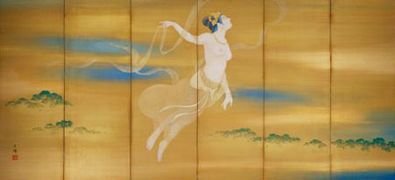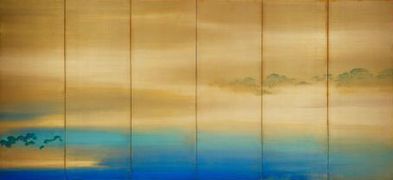Nishiyama Suishō
Nishiyama Suishō ( Japanese 西山 翠 嶂 , real first name Usaburō ( 卯 三郎 ); born April 2, 1879 in Kyōto ; died March 30, 1958 ) was a Japanese painter in the Western Yōga style of the Taishō and Shōwa periods . He was, together with Kikuchi Keigetsu , one of the central figures of the Kyōto art scene of his time.
life and work
Nishiyama was a student of Takeuchi Seihō and then his son-in-law. In 1899 he graduated from the School of Arts and Crafts in Kyōto ( 京都 市立 美術 工 芸 学校 ). He was then represented with works at exhibitions such as the "Trade Fair for Economic Development" ( 内 国 勧 業 博 覧 会 , Naikoku kangyō hakurankai ), as well as the art exhibitions Shin kobijutsu behind ( 新 古 美術品 展 ) and Zenkoku kaiga kyōshinkai ( 全国絵 画 共進 共進 ).
From 1907 onwards, Nishiyama exhibited “Bunten” every year at the annual state art exhibition and was shown with images such as “Unadorned Woman” ( 未 笄 の 女 , Mike no onna ), “Short Night” ( 短 夜 , Tan'ya ), “ Falling plum blossoms ”( 落梅 , Rakubai ) excellent.
From 1902 Nishiyama taught at the School of Arts and Crafts, from 1919 at the Kyōto Municipal Art School ( 京都 市立 美術 学校 , Kyōto shiritsu bijutsu gakkō ). In the same year he became a juror for the "Teiten" exhibition, which continued the colorful. At this exhibition he showed his work “ Fütterung ” ( 秣 , Magusa ), which earned him criticism, on the one hand because of the trivial rural subject, on the other hand because of the vague execution. Nishiyama continued to develop painting in the Nihonga style.
From 1933 to 1936, Nishiyama was the director of both the School of Arts and Crafts and the Municipal Art School. In 1929 he was a member of the Academy of Arts ( 美術 院 , Teikoku bijtsu-in ). In 1937 he was confirmed as a member of the successor organization , and in 1944 he was appointed art expert at the Imperial Court ( 帝室 芸 妓 員 , Teishitsu geiki-in ). In 1957 Nishiyama was awarded the Order of Culture .
Nishiyama's disciples include Dōmoto Inshō and Uemura Shōen . In 1990 the Japanese Post issued a 62-yen stamp with a horse image of Nishiyama in the series "Horse in Culture".
photos
Remarks
- ↑ Kinshōjo ( 絹 祥 女 ) is a female character from the Kabuki theater.
- ↑ The first character, U = 卯 , indicates the year of birth in the context of the Sino-Japanese branches of the earth , here 1879
- ↑ At that time painting was still classified as a craft.
- ↑ Bunten ( 文 展 ) is the abbreviation for the exhibition of the Ministry of Culture "Monbushō bijutsu tenrankai" ( 文部省 美術展 覧 会 ). After the reorganization in 1919, the exhibition was called “Teiten” ( 帝 展 ) = “Teikoku bijutsu tenrankai” ( 帝国 美術展 覧 会 ).
literature
- S. Noma (Ed.): Nishiyama Suishō . In: Japan. An Illustrated Encyclopedia. Kodansha, 1993, ISBN 4-06-205938-X , p. 1101.
- National Museum of Modern Art, Kyoto (ed.): Nishiyama Suishō . In: Kyoto no Nihonga 1910–1930. Kyoto 1986, ISBN 4-87642-117-X .
- Laurance P. Roberts: Nishiyama Suishō . In: A Dictionary of Japanese Artists. Weatherhill, 1976. ISBN 0-8348-0113-2 .
Web links
| personal data | |
|---|---|
| SURNAME | Nishiyama, Suishō |
| ALTERNATIVE NAMES | 西山 翠 嶂 (Japanese); Nishiyama, Usaburō (real name); 西山 卯 三郎 (real name, Japanese) |
| BRIEF DESCRIPTION | Japanese painter |
| DATE OF BIRTH | April 2, 1879 |
| PLACE OF BIRTH | Kyoto |
| DATE OF DEATH | March 30, 1958 |





